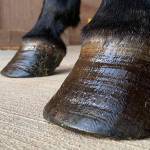Cellular Mechanisms of Laminitis: Latest Research

An international group of researchers recently proposed a theory to explain the cellular pathways involved in the development of laminitis, including the role of apoptosis, a normal process of self-destruction that helps eliminate damaged, superfluous, or unwanted cells. Unfortunately, their data showed that apoptosis did not influence the development of laminitis. Had their hypothesis held, however, targeted treatments for laminitis may have followed.
Laminitis is the painful separation of the lamellar layers of the hoof, which often results in profound lameness, prolonged and expensive supportive care, and possible euthanasia. Despite extensive research in this field, many of the underlying mechanisms associated with the development of laminitis remain unclear.
The abovementioned theory proposed that sepsis-related laminitis, such as that induced by carbohydrate overload and black walnut exposure, involves apoptosis of cells that bind the lamellar layers of the hoof. The integrity of those cells helps suspend the third coffin bone inside the hoof. Researchers suggested that apoptosis occurs early in the disease process, even before signs of lameness manifest. Specifically, they proposed that exaggerated inflammation occurring with the presence of bacteria in the bloodstream could serve as a source of free radicals, which are known to induce apoptosis.
To test their theory, the researchers used hoof samples from horses subjected to carbohydrate overload or exposed to black walnut extract. Both models induce lamellar inflammation and sepsis. “When the researchers counted inflammatory and apoptotic cells microscopically, no increase in apoptosis was observed during either the development phase of laminitis or at the time of lameness onset,” relayed Whitehouse.
Though disappointing, these results sent researchers back to the drawing board in search of other mechanisms that contribute to the development of laminitis.
Meanwhile, horse owners must continue to employ management and nutritional strategies that keep horses safe from the ravages of laminitis. “In addition to avoiding management triggers, ensure horses have adequate nutrients to support the well-being of all body systems, including the integumentary system, which includes skin, hair, and hooves,” explained Catherine Whitehouse, M.S., a nutrition advisor for Kentucky Equine Research.
“To dodge potential nutrient shortages, all horses should receive a fortified feed suitable for their energy needs,” she said. This feed may come in the form of a traditional textured or pelleted concentrate or it may come as a balancer pellet, which is often useful for horses that can maintain their weight on forages alone.
Horses with compromised hooves may require additional support in the form of a high-quality hoof supplement. “A comprehensive hoof supplement provides more than just biotin to foster hoof growth and integrity. In addition to diet, routine management such as trimming or shoeing plays a vital role in maintaining and achieving hoof health that will also serve the horse well in the face of a laminitis episode,” Whitehouse explained.
Chronic inflammatory conditions, like laminitis, often respond to supplementation with omega-3 fatty acids, especially DHA and EPA. The omega-3s found in certain marine-derived products, like EO-3, are more available to horses than those found in plant-based sources.
*Catunda, A.P.N., G.E.S. Alves, F.O.P. Leme, A.M. Carvalho, B.S. Leise, P.J. Johnson, and R.R. Faleiros. 2021. Apoptosis in epithelial cells and its correlation with leukocyte accumulation in lamellar tissue from horses subjected to experimental sepsis-associated laminitis. Research in Veterinary Science 136:318-323.








